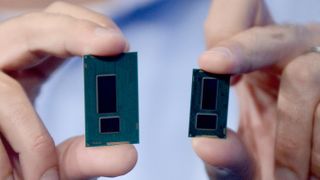Will Intel's Skylake processor sink Broadwell before it can swim?
The quirks of the roadmap

Just as Intel begins shipping its Broadwell CPUs early next year their successors will already be with software developers.
Will there be any point in upgrading to the 5th Gen Core processors when a whole new 6th Gen Core architecture is potentially just six months away?
From a PC point of view, one of the exciting parts of Intel's only keynote at this year's IDF was the announcement that Broadwell's 14nm process had finally hit volume production.
That means 5th Gen Core desktop chips are coming early next year, hot on the heels of the li'l Core M. Yay, we do so love a new performance processor.
Only Intel's Kirk Skaugen also announced that at the same time the Broadwell Core i3s, i5s and i7s are hitting the shelves, reference Skylake development platforms will be shipping out to software developers.
Volume production, and launch, of the brand new Skylake processors will follow some six months later in the second half of 2015.
Skylake, the code-name for the 6th Gen Core CPUs, is a new microarchitecture, using the current 14nm production process. 'You should expect a significant increase in performance, in battery life, in power efficiency,' says Skaugen.
Get daily insight, inspiration and deals in your inbox
Get the hottest deals available in your inbox plus news, reviews, opinion, analysis and more from the TechRadar team.
Broadwell though is only likely to offer a relatively small performance boost over the current Haswell chips. It is essentially the same architecture as Haswell, only shrunk down to the 14nm level from the existing 22nm process.
Power efficiency is the name of the game then for Broadwell, only with a bit more of a straight performance boost on the GPU side of things.
That's going to make the top mobile part, the Core M, an outstanding high-end, fanless tablet chip, but on the desktop that doesn't really amount to a lot when you just want more performance to justify your upgrade.
So will Broadwell be worth a punt on the desktop?
In the standard configurations, possibly not, but there is at least one bright spot and that's the prospect of a socketed Broadwell processor with the top end Iris Pro graphics inside.
"What we haven't had is the ability to have a socketed desktop processor with really high performance integrated graphics." Intel's Lisa Graff told us at the show. "Especially for desktop that will be the big hitter for us with Iris Pro graphics."
In the previous Haswell generation you only had one option, the soldered-on i7 4770R that went into those pricey NUCs. With a socketed version you could drop it into a cheaper mini-ITX H97 and have yourself a teeny machine with some decent integrated GPU oomph.
For the upgraders then that's quite a tantalising prospect.
While the CPU architecture of Broadwell hasn't much changed from Haswell, bar the die-shrink, the GPU part seems to be aping the accelerated tick-plus change which occurred in the move from Sandy Bridge to Ivy Bridge.
The GT2 graphics in the normal Iris GPU component comes with another four extra execution units (EUs), making a total of 24, and so we expect the GT3e Iris Pro parts to come with around double that at 48 EUs.
While you're never going to be hitting 4K levels of PC gaming, the new Iris Pro will still be able to deliver decent 1080p performance, and hopefully this time around in a more affordable form on the desktop.
